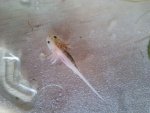Bette
New member
- Joined
- Jan 15, 2013
- Messages
- 975
- Reaction score
- 18
- Points
- 0
- Location
- Massachusetts, USA
- Country
- United States
- Display Name
- LadyAquarius
Hi Everyone! I recently noticed that one of my hatchlings has unusual coloring. It looks as if it could be perhaps a chimera or harlequin! I am so excited to see how it turns out! What do y'all think?
Just today, I posted pics of it in the forum's photo gallery.
http://www.caudata.org/forum/members/bette-albums-bette-s-axolotls-possible-chimera-harlequin.html
Just today, I posted pics of it in the forum's photo gallery.
http://www.caudata.org/forum/members/bette-albums-bette-s-axolotls-possible-chimera-harlequin.html







